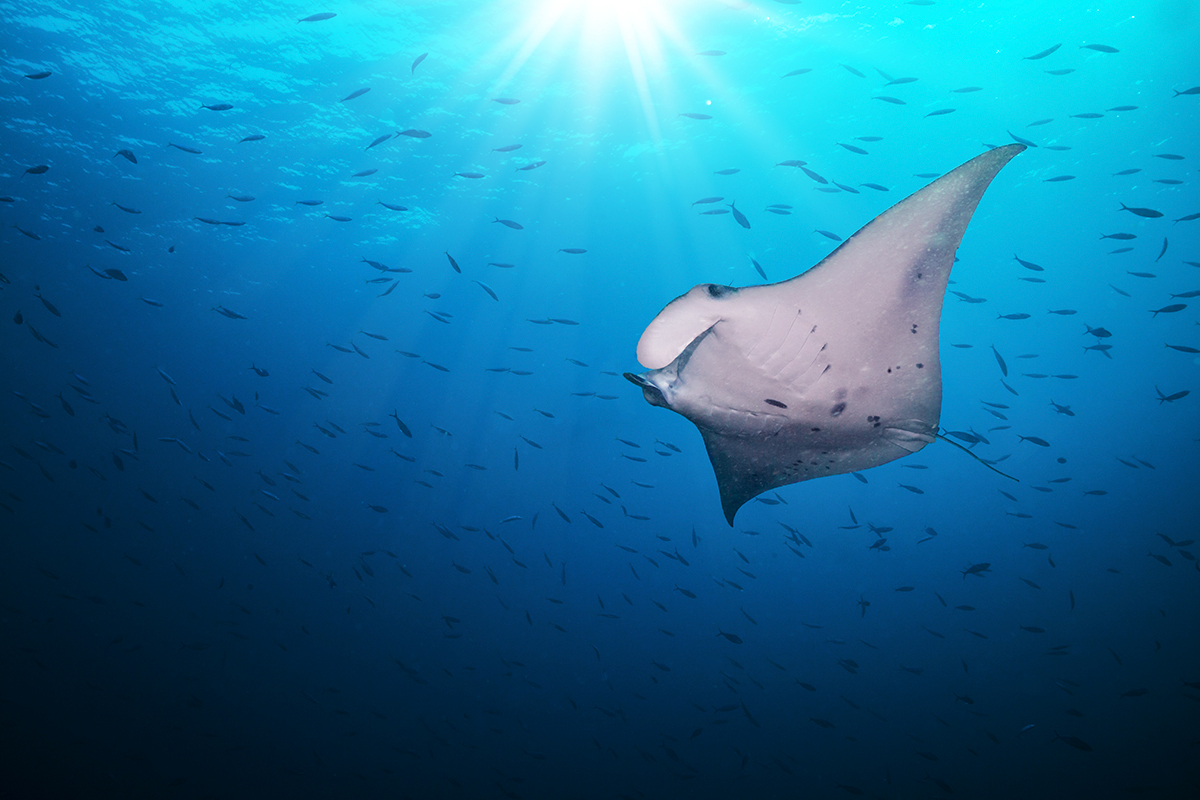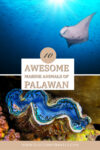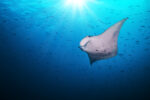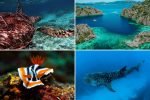Before you plan your Philippines diving itinerary, check out this guide to the incredible marine animals of Palawan and where to see them under the sea
With towering limestone cliffs clad in neon green jungle bursting forth from sparkling blue waters, pristine white beaches and countless lagoons, lakes and tropical forests, Palawan is one of the most beautiful parts of all of the Philippines.
This elongated chain of islands running diagonally from the northeast to the southwest is located on the far western periphery of the Philippines. It stands out as a prime destination for travelers and it’s easy to see why.
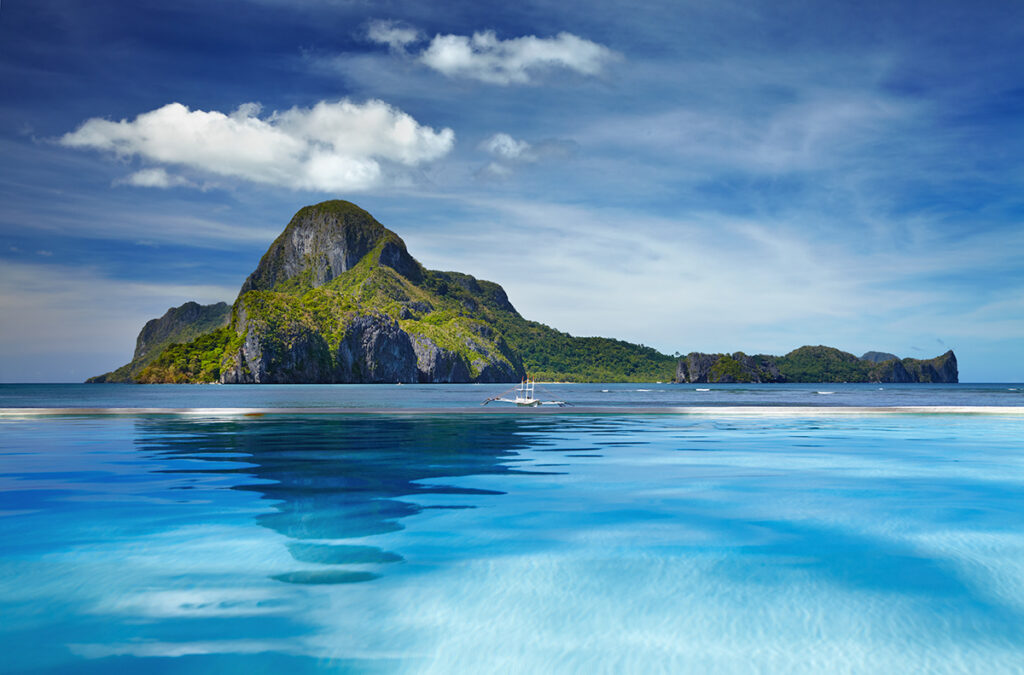
Palawan offers a myriad of activities, including trekking, caving, beach-hopping, partying, tribal experiences and more. In this post, however, we’ll delve into the mesmerizing underwater wonders of Palawan and the amazing marine animals of Palawan that scuba divers can discover beneath the waves.
The marine ecosystems in Palawan’s waters are truly remarkable. Protected from the 2021 typhoons which devastated coral reefs in other parts of the Philippines, Palawan is home to a thriving marine environment that is absolutely teeming with life. The waters of the archipelago offer some of the best opportunities for encountering marine life in the Philippines.
Curious about what marine species can be seen in Palawan? You’ve come to the right place. Here’s our guide to 10 of the most incredible marine animals of Palawan, and tips on where you can see them!
Coral Reefs – Coron, El Nido & Tubbataha Marine Park
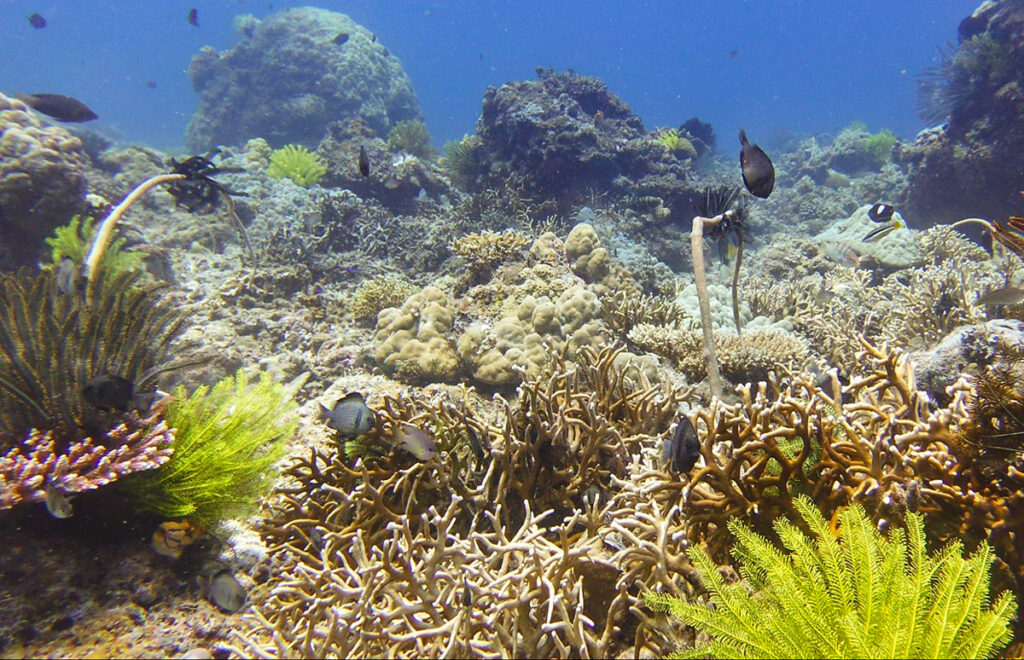
The Philippines is renowned for its magnificent coral reefs and Palawan takes the crown for the finest of them all. Beginning at the northernmost point of Palawan, you’ll find Coron, where 10 shipwrecks from the Japanese Imperial Navy during World War 2 are nestled within the boundaries of recreational scuba diving. These wrecks are adorned with colourful coral reefs on their exteriors.
Heading further south, you’ll come across El Nido, a highly popular destination, especially among backpackers. El Nido is famous for its towering limestone cliffs and vibrant beach-hopping tours and parties. But journey through the crowds of backpackers, bars and clubs and you’ll find numerous dive centres where you can arrange to explore the 40+ dive sites of El Nido Bay.
It is in this area that you can find some of the most extensive and healthy coral reefs in all of the Philippines, set against a diverse and exciting underwater landscape featuring many walls, canyons and even underwater tunnels.
For those with the means to embark on a liveaboard adventure; there’s another epic destination to consider – Tubbataha Marine Park. Located some 50 kilometres to the east of Puerto Princesa (the central-based capital of Palawan), this protected open ocean area spans an impressive 95,000 hectares and is characterized by an underwater landscape adorned with numerous extinct underwater volcanos, pinnacles, canyons and ridges, many of which are cloaked in pristine and expansive hard and soft coral reefs.
It’s worth noting, however, that because Tubbataha Marine Park is only accessible via liveaboard, it’s both more complicated and expensive to reach than Coron and El Nido.
Manta Rays -El Nido and Tubbataha Marine Park
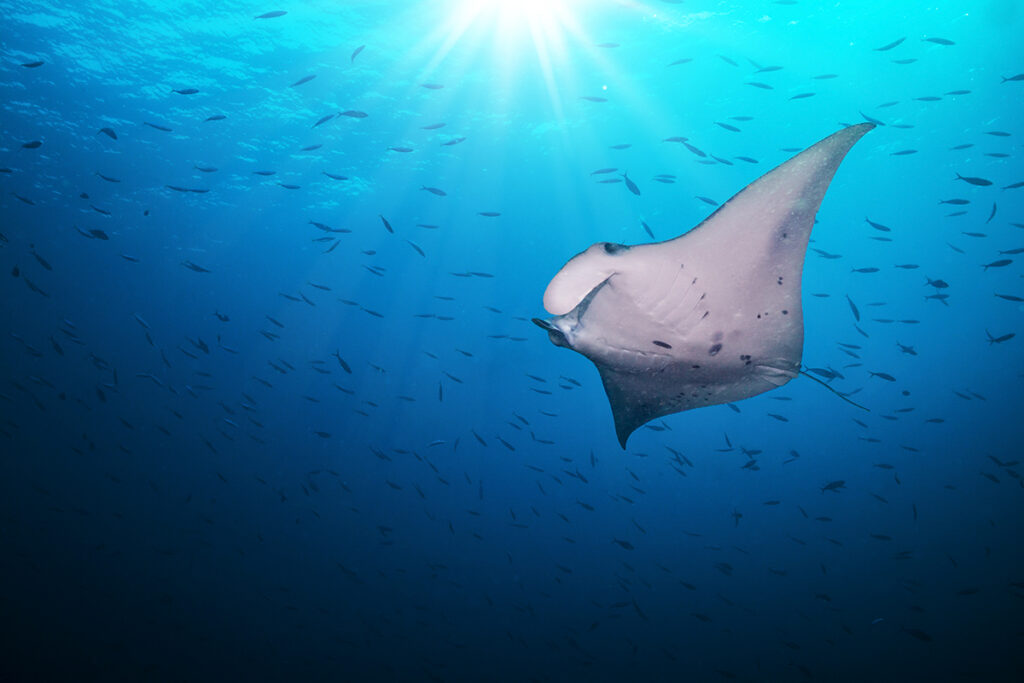
My all-time favourite marine animals are manta rays, widely regarded by many scientists as the most intelligent fish in the ocean. They have the remarkable ability to recognize themselves in mirrors and display distinct personalities. Often found in groups, these highly social and ethereal beings are renowned for their graceful movements and the flips and somersaults they perform in the water as if they are dancing among themselves.
Located just fifty minutes drive from El Nido town, Sibaltan is a quiet seaside village that still remains relatively off the beaten track. It is, however, the best place in the Philippines that you can easily reach and observe manta rays. There are several local dive sites around Sibaltan consisting of manta ray cleaning and feeding stations where these majestic creatures can frequently be seen.
It’s also possible to spot manta rays at Tubbataha Reef Marine Park but because the latter is only reachable via liveaboard this is much more expensive and challenging compared to heading to El Nido for manta ray sightings. However, while in Sibaltan, El Nido, you’ll primarily encounter reef manta rays, which can reach widths of up to 16 feet, lucky divers exploring Tubbataha Marine Park may also witness the even larger oceanic manta rays which can grow to an astonishing 29 feet in width!
Dugong – Coron
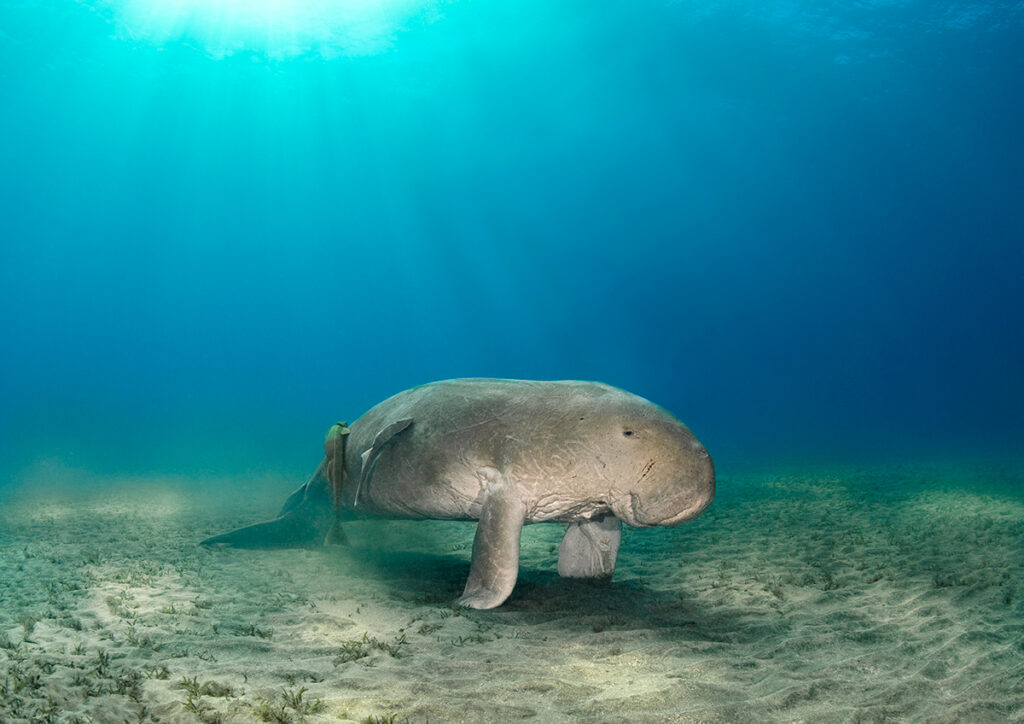
Dugongs, often referred to as sea cows, are aquatic animals inhabiting relatively shallow tropical waters. They feed exclusively on sea grasses, and they play a crucial role as ecosystem engineers.
Contrary to the belief that they damage seagrasses, Dugong actually contributes to maintaining the health and vitality of seagrass beds, making them a highly significant species for habitat preservation. Dugongs belong to the order Sirenia, one of four living species within this category, with their closest relatives being manatees.
These peaceful and generally solitary creatures can hold their breath for up to six minutes and reach lengths of up to ten feet and can weigh as much as 2000 pounds (900kg). They are typically slow-moving but can exhibit short bursts of speed when necessary.
Despite their size and strength, Dugongs are quite shy animals and pose little threat to humans. Whilst many scuba divers visit Coron solely to explore the remarkable Japanese WW2 shipwrecks and perhaps Barracuda Lake, what remains largely unknown to most is that a half-day trip to North Busuanga from Coron Town can lead to encounters with these incredible creatures. Around North Busuanga, there are several local dive sites where divers have a 50 / 50 chance of seeing Dugongs! Of course – if you don’t see Dugong, no refunds are given!!
Nurse Sharks – El Nido & Tubbataha Reef
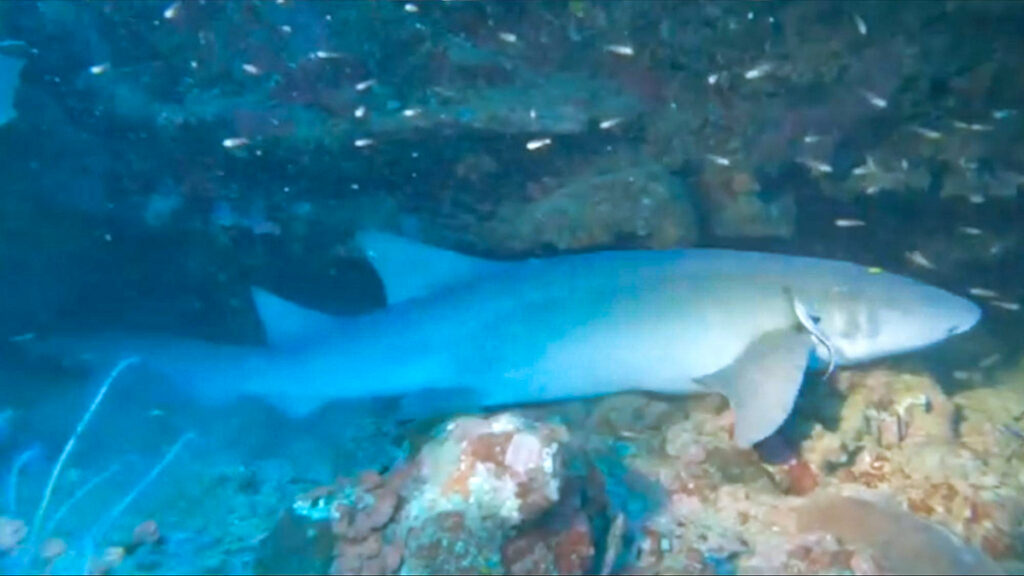
During my recent scuba diving adventure (May 2023), there was just one day when I opted not to dive. Ironically, on that very day, a group of divers had the incredible fortune of spotting an enormous 10-foot-long Tawny Nurse Shark leisurely resting on the seafloor near my favourite El Nido dive site -Dilumacad Tunnel.
Tawny Nurse Sharks belong to the carpet shark family, which means that unlike most shark species, which must continually swim to prevent drowning, carpet sharks have the unique ability to remain completely motionless on the seafloor, a big advantage that allows them to conserve energy.
Nurse sharks typically employ this resting behaviour during the day, appearing rather sluggish. However, by night they become much more active as they begin to hunt for their favourite food: crustaceans and squid! Whilst quite common at Tubbataha Marine Park, Tawny Nurse Sharks are not actually the most common sight at El Nido, which just goes to show that you never know what you’ll discover on a dive (after all, the entire world’s oceans are connected, so technically anything could pop up anywhere!).
Turtles – Coron, El Nido, Tubbataha Marine Park
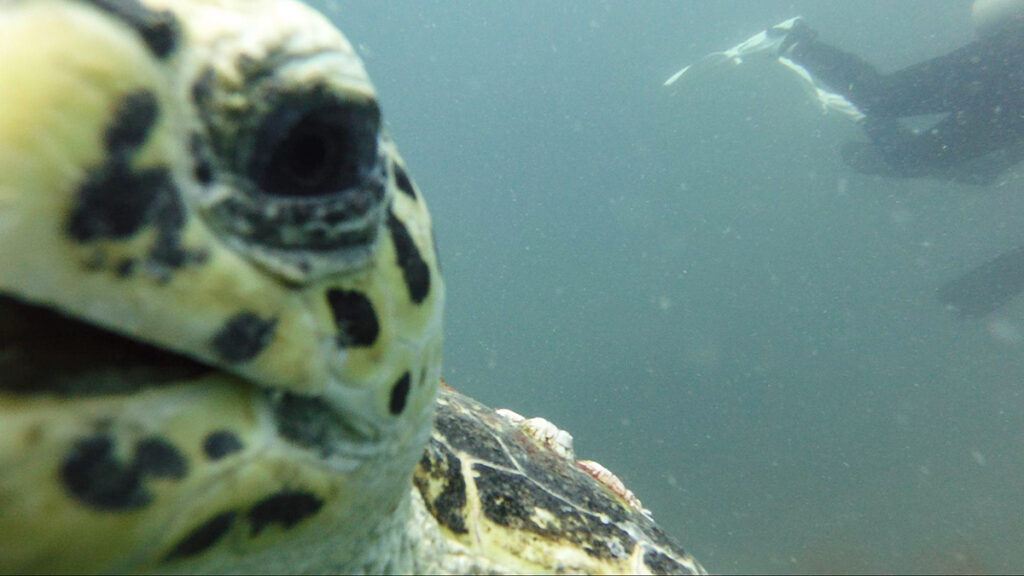
Turtles are plentiful in many parts of the Philippines and Palawan is no exception. The most commonly encountered sea turtle in the Philippines is the green sea turtle, which is the second largest marine turtle species, growing up to 5 feet in length and weighing as much as 700 pounds.
What sets green sea turtles apart is their unique herbivorous diet, consisting entirely of algae and seagrasses which is the cause of the greenish tinge to their shells. These gentle giants are easily approachable and usually spotted on their own but sometimes in twos or threes.
Lucky divers may also spot the critically endangered hawksbill turtle which is instantly recognizable by its beak-like jaws, which, unlike the vegetarian green sea turtle, are adapted for tearing into jellyfish and soft coral. I’ve had the privilege of witnessing both green sea turtles and hawksbill turtles in various parts of the Philippines including Coron and El Nido – and I can also verify that they’re plentiful around Tubbataha Marine Park!
Garden Ribbon Eels – El Nido, Tubbataha Marine Park
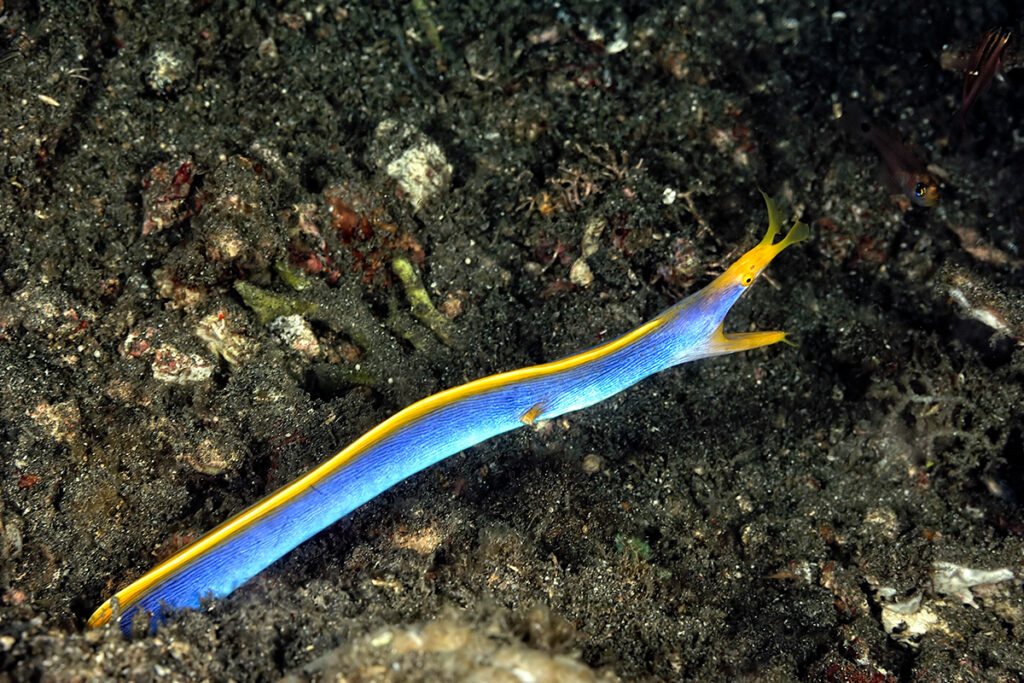
So, you’re curious about what a garden ribbon eel is? These lesser-known eels, also known as leaf-nosed ribbon eels, possess an extraordinarily distinct appearance so that even if you’ve never heard of a garden ribbon eel, once you see one, you’ll never forget it!
They have a laterally compressed, elongated body that is a striking jet-blue, with a long, yellow dorsal fin on top, running the entire length from tip to tip. Their heads, which remind me greatly of a small aquatic Chinese dragon, are elongated and snout-like; and protruding from the ends of these snouts are two bright yellow anterior nostrils that resemble flowers emerging from their noses.
Reaching lengths of up to one meter, Garden Ribbon Eels, are typically spotted alone or in pairs, poking out of crevices and occasionally snatching up small fish or crustaceans that come too close. If you’re lucky enough to see one moving along the sea floor, you’ll be amazed at how its entire body appears to gracefully ripple, much like a brightly coloured ribbon fluttering in a soft breeze.
After years of diving, I finally saw my first garden ribbon eel at El Nido; its bright blue and yellow head poking forth from a crevice and weaving from side to side as it waited for some tasty morsel to come close.
Whale Shark
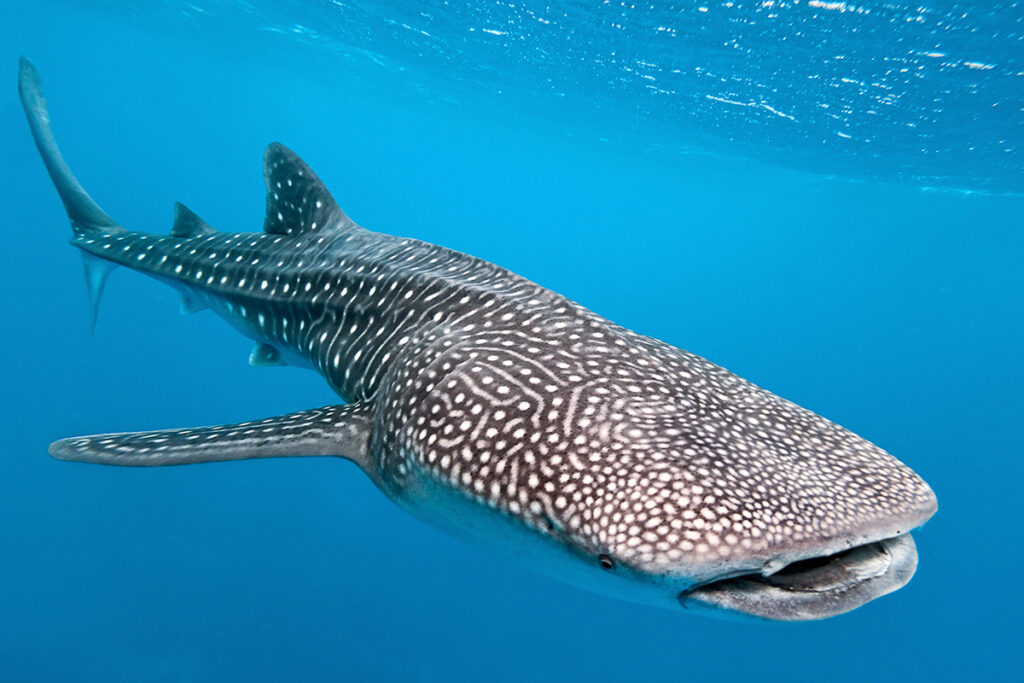
Here’s one of Palawan’s marine animals that needs no introduction. Reaching insane lengths of up to 60ft (18 meters) and weighing as much as 20 tonnes, the whale shark holds the title of being the largest living shark and, indeed, the largest living fish globally.
But despite its gargantuan size, the whale shark is in fact a gentle filter feeder, dining on plankton, tiny fish and krill. Whale sharks have an extremely distinctive appearance, featuring a broad, flat head and an enormous gaping mouth that can stretch up to 5 feet wide! They are covered in dark gray or blue skin adorned with white spots and stripes. Together, these spots and stripes make up a pattern unique to the individual whale shark, much like a human fingerprint.
These magnificent creatures are found in warm tropical and subtropical waters worldwide, including the Philippines. Technically they can pop up anywhere, but one of the best places to see them is Tubbataha Marine Park, which is only accessible via liveaboard making it one of the most remote and secluded diving spots in the entire Philippines.
Nudibranch – Coron, El Nido, Tubbataha Marine Park
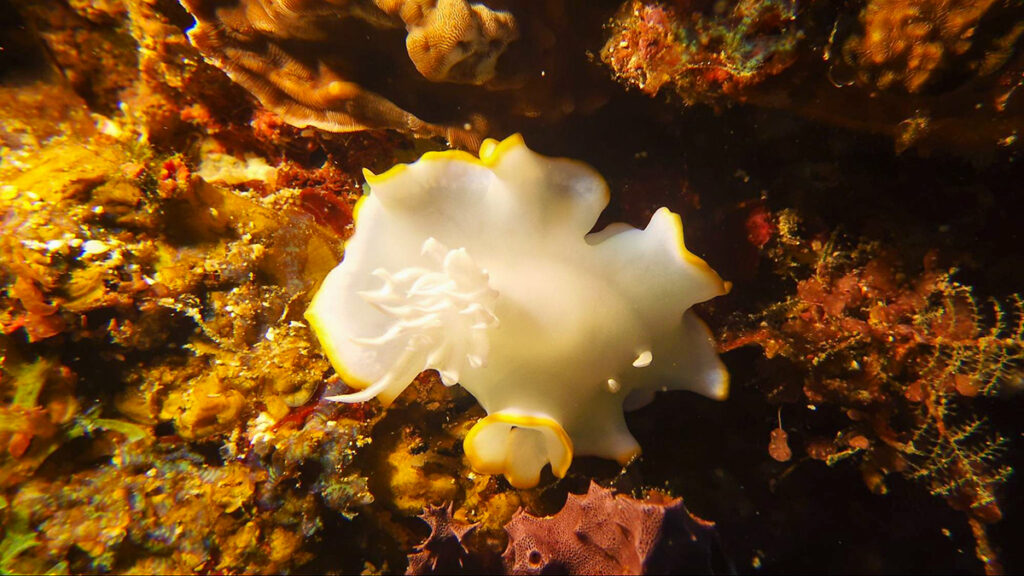
Nudibranch are a fascinating group of gastropod molluscs known for their vibrant and diverse appearances. Found in tropical, temperate and cold waters alike, they come in a wide array of shapes, colours, sizes and patterns from tiny individuals no larger than a grain of rice which up close resemble… woolly sheep (!), to much larger individuals several inches long with striking hues of colour like jet blue, red, green or purple.
Many scuba divers view Nudibranch as icons of the diving world and indeed a lot of divers I’ve met obsessively “collect” nudibranchs – not in the physical sense but by checking off which of the near countless species they see throughout their dives around the world.
Most species of nudibranch feed on sponges and coral, occupying a crucial (and not always very well understood) niche in the coral reef ecosystem. The Philippines is a true paradise for Nudibranch lovers. At just about any Philippines dive destination, Coron, El Nido and Tubbataha Marine Park included, it’s extremely common and easy to spot multiple species of nudibranch on any one single dive!
Grey Reef Sharks – Tubbataha Marine Park
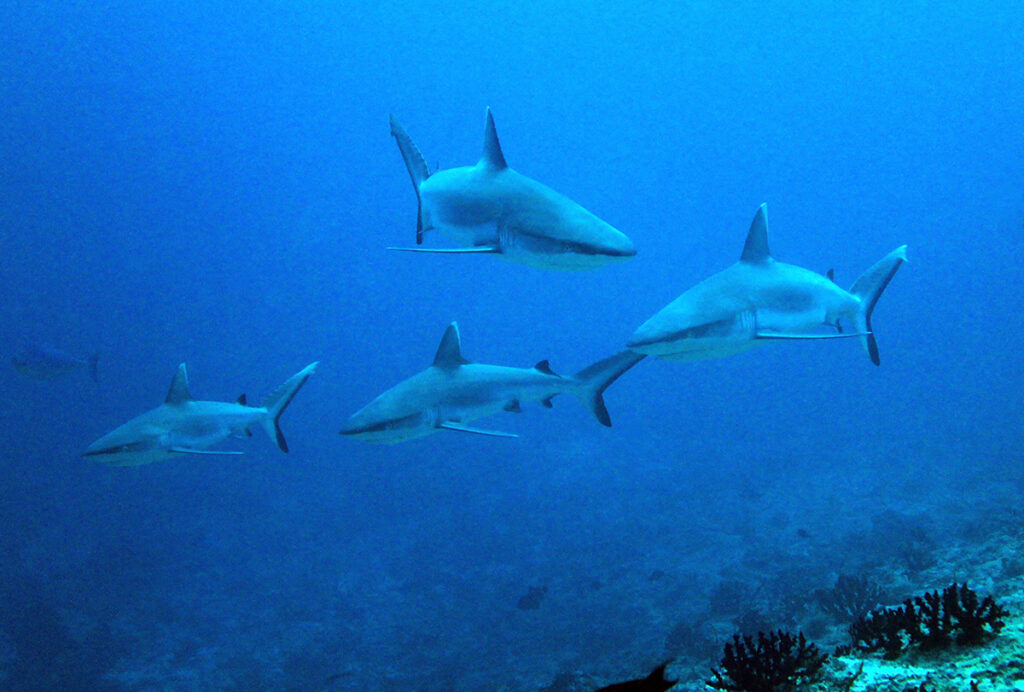
An awe-inspiring spectacle pretty much exclusive to Tubbataha Reef as far as the Philippines is concerned is that of hundreds of schooling gray reef sharks. Usually measuring around 5 – 6 feet long, gray reef sharks are, as their name suggests, gray sharks (with white underbellies) that are typically found around coral reef ecosystems.
These requiem sharks are efficient hunters, primarily targeting reef fish, smaller sharks, rays and crustaceans. They’re also remarkably sociable, often forming schools of hundreds of individuals, especially during daylight hours.
Generally speaking, gray reef sharks are not aggressive towards humans unless they feel threatened or cornered. Even then, they’re courteous enough to give a warning before taking any aggressive action.
This warning behaviour involves raising the snout, depressing the pectoral fins and arching their backs whilst swimming in an exaggerated manner. So, if you happen to witness a gray reef shark behaving like this, move out of the way and gain distance whilst staying calm and you’ll remain safe.
Grey reef sharks actually play a pivotal role in regulating the populations of their prey species within the reef ecosystem, thus serving as an essential component of the overall ecological balance. Lucky divers exploring Tubbataha Reef may have the exceptional opportunity of witnessing many hundreds of gray reef sharks passing by in their natural habitat.
Giant Clams – El Nido
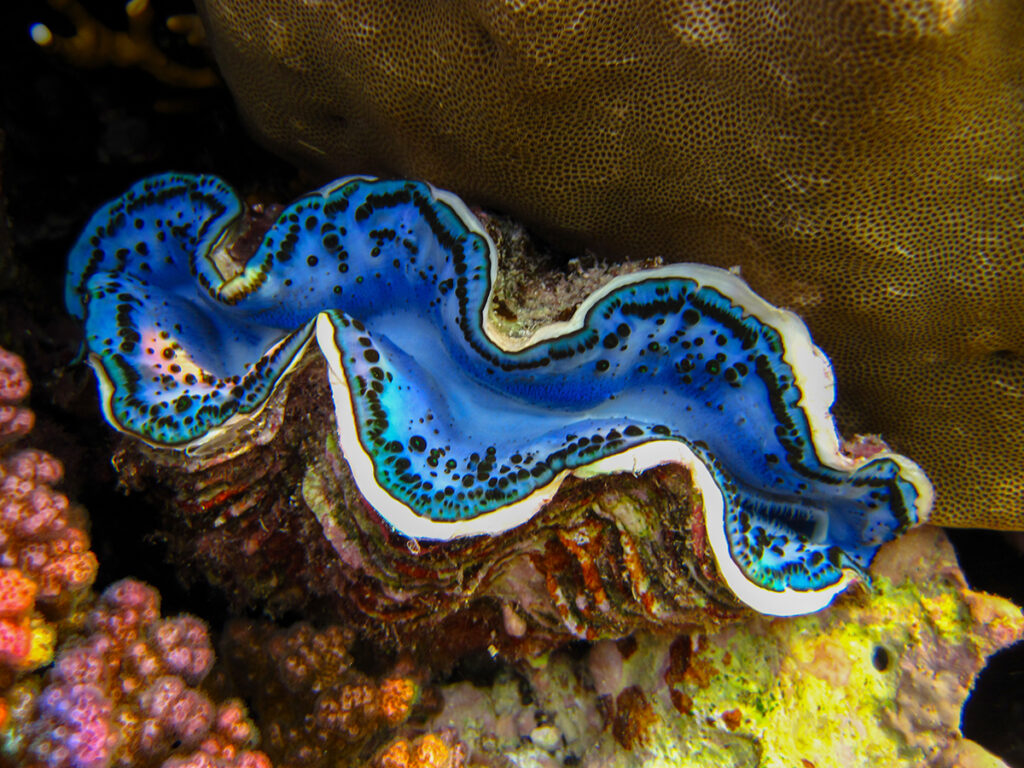
Renowned for their spectacular appearance and formidable size, giant clams can reach lengths of up to 4.5 feet and weigh several hundred pounds.
Beyond their impressive size, the soft-bodied part of these clams, visible through their open shells, showcases a stunning array of colours. Their flesh can exhibit shades of bright blue, purple, green and yellow, often adorned with intricate patterns and markings.
These vibrant hues are actually the result of a symbiotic relationship with an algae known as Zooxanthellae residing within the clam’s tissues. The algae play a vital role by supplying the clams with sugars and oxygen through photosynthesis, enabling the clams to harvest energy from sunlight.
Additionally, giant clams can also capture plankton and other small particles from the water via filter-feeding, but most of their nutrients come from the symbiotic algae.
In return, the algae get a safe home to live within so both species benefit. Giant clams are sessile (stationary) organisms. Typically, they attach themselves to rocks or coral in clear, shallow waters with easy access to sunlight. Thus, although they may seem like simple creatures, giant clams boast a complex symbiotic relationship and ingenious feeding mechanism. One of the best places to witness them is around the sparkling turquoise waters of El Nido Bay. The clams are must-see representatives of El Nido marine life.
Final Thoughts on Marine Animals of Palawan
Hope you enjoyed reading our guide to some of the most incredible marine animals of Palawan. From whale sharks to ribbon eels, these are magnificent creatures to see in their natural element.
Beyond the opportunities to encounter marine wildlife, this exceptional region of the Philippines provides a diverse and exciting range of scuba diving experiences that are challenging, if not impossible, to come by in other parts of the country and Southeast Asia.
About the Author
Alex is the creative mind and the adventurer behind the Diving Squad blog. The insights shared in this post are drawn from his own extensive diving experiences in the Philippines over multiple trips spanning nearly a decade! For further details on diving in Palawan and other areas of the Philippines, head over to his blog’s main page on diving the Philippines.

